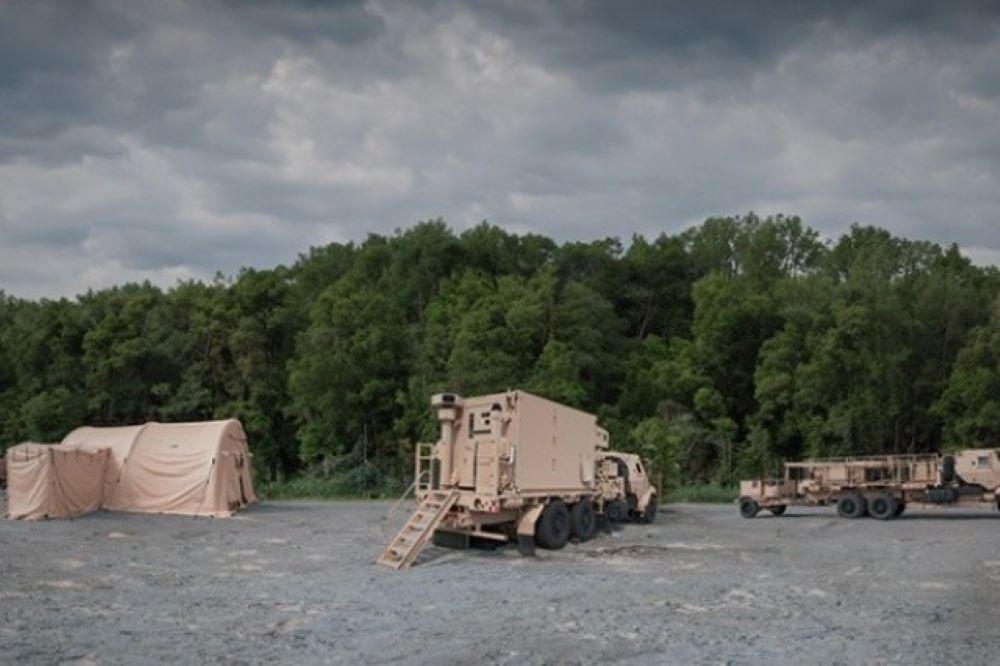
The U.S. Army’s first Integrated Battle Command System following delivery in April.
HUNTSVILLE, Alabama—Spurred by a global focus on air defense, Northrop Grumman says it is fielding increased international interest in its Integrated Battle Command System (IBCS) as it looks to upgrade the system amid U.S. Army testing.
The company has received four letters of request for price and availability for IBCS from undisclosed countries and is finalizing responses to the last two. The first international customer, Poland, is looking to increase its fielding of the system to center its medium and short-range air defense programs, says William Lamb, Northrop Grumman’s IBCS director.
Northrop has completely delivered the first IBCS squadron and Patriot batteries for Poland, with another phase of three more squadrons planned as part of the Polish military’s Wisla medium-range air defense program. This also includes the first integration of IBCS with the MBDA Command Anti-Air Modular Missiles, Lamb says.
The timing of the next deliveries of IBCS depend on Northrop Grumman getting a contract with the U.S. Army, and Poland would like to take deliveries in 2026, he says.
Poland is also forming its Narew short-range air defense program, using IBCS as the centerpiece of 11 squadrons. These will include 23 IBCS batteries, Lamb says.
Beyond Poland, Lamb says IBCS has an opportunity to grow among the 18 countries in addition to the U.S. that have fielded the Patriot air defense system. Modernization opportunities for Patriot are centered on newer PAC-3 Missile Segment Enhanced interceptors, IBCS and integrating the Lower Tier Air and Missile Defense Sensor (LTAMDS).
In the U.S., the Army approved full-rate production for IBCS last year and Northrop is delivering from its Huntsville production line to Army testing. The first unit, the 3-43 Air Defense Artillery at Fort Bliss, Texas, will conduct the qualification testing while the training unit at Fort Sill, Oklahoma, stands up. The first full IBCS system was delivered in April.
Full operational test and evaluation (FOT&E) will run from March-June, including flight tests. Lamb says the FOT&E process will address findings out of the initial test and evaluation process. The Pentagon’s Department of Test and Evaluation in its final report on IBCS highlighted software deficiencies that caused system limitations.
Once there is a formal fielding decision, the Army expects to bring on two battalions per year.
The IBCS program of record now includes the integration with Patriot, LTAMDS, the Sentinel A-4 radar and the Army’s integration of the Indirect Fire Protection Capability. Northrop Grumman is also integrating Lockheed Martin’s Remote Interceptor Guidance-360 missile communication device, which allows inflight data link connections with Patriot PAC-3 missiles. This permits the interceptor to be directed by other radars beyond the Patriot’s own.
Another way Northrop is looking to change IBCS, spurred by U.S. Army criticism, is the IBCS’s command center. This is now a static tent, which would make a relatively simple target—especially based on lessons learned in the war in Ukraine. Northrop is determining ways to make the unit mobile, or splitting up operators to different locations and have them collaborate virtually.
Northrop Grumman showed a broadened vision of its air defense plan ahead of the Space and Missile Defense Symposium here on Aug. 5. This system, called BattleOne, includes even more sensors and weapons systems connected to IBCS. It consists of space-based resources such as the company’s Hypersonic and Ballistic Tracking Space Sensor Satellites, aircraft such as E-3 AWACS and F-35s, and sensors at sea. While Northrop has demonstrated IBCS connecting with an F-35, it has not become part of the official program. IBCS will be connected with the U.S. Navy’s Aegis system as part of the broad defense of Guam architecture, the Missile Defense Agency says.
